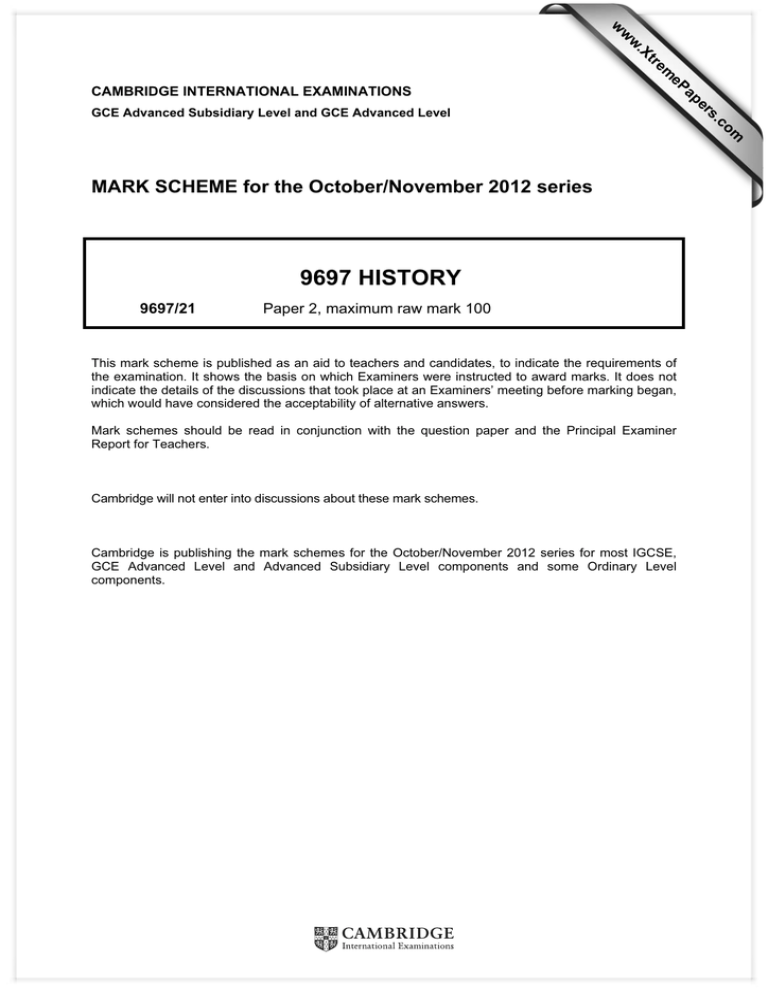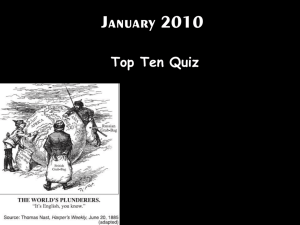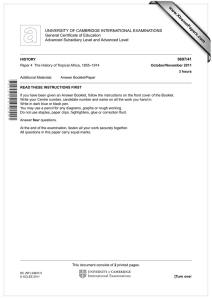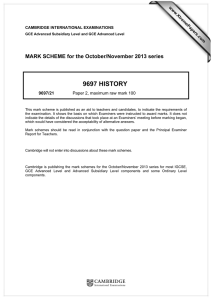9697 HISTORY MARK SCHEME for the October/November 2012 series
advertisement

w w ap eP m e tr .X w CAMBRIDGE INTERNATIONAL EXAMINATIONS 9697 HISTORY 9697/21 Paper 2, maximum raw mark 100 This mark scheme is published as an aid to teachers and candidates, to indicate the requirements of the examination. It shows the basis on which Examiners were instructed to award marks. It does not indicate the details of the discussions that took place at an Examiners’ meeting before marking began, which would have considered the acceptability of alternative answers. Mark schemes should be read in conjunction with the question paper and the Principal Examiner Report for Teachers. Cambridge will not enter into discussions about these mark schemes. Cambridge is publishing the mark schemes for the October/November 2012 series for most IGCSE, GCE Advanced Level and Advanced Subsidiary Level components and some Ordinary Level components. om .c MARK SCHEME for the October/November 2012 series s er GCE Advanced Subsidiary Level and GCE Advanced Level Page 2 Mark Scheme GCE AS/A LEVEL – October/November 2012 Syllabus 9697 Paper 21 GENERIC MARK BANDS FOR ESSAY QUESTIONS Examiners will assess which Level of Response best reflects most of the answer. An answer will not be required to demonstrate all of the descriptions in a particular level to qualify for a Mark Band. Band Marks Levels of Response 1 21–25 The approach will be consistently analytical or explanatory rather than descriptive or narrative. Essays will be fully relevant. The argument will be structured coherently and supported by very appropriate factual material and ideas. The writing will be accurate. At the lower end of the band, there may be some weaker sections but the overall quality will show that the candidate is in control of the argument. The best answers must be awarded 25 marks. 2 18–20 Essays will be focused clearly on the demands of the question but there will be some unevenness. The approach will be mostly analytical or explanatory rather than descriptive or narrative. The answer will be mostly relevant. Most of the argument will be structured coherently and supported by largely accurate factual material. The impression will be that that a good solid answer has been provided. 3 16–17 Essays will reflect a clear understanding of the question and a fair attempt to provide an argument and factual knowledge to answer it. The approach will contain analysis or explanation but there may be some heavily descriptive or narrative passages. The answer will be largely relevant. Essays will achieve a genuine argument but may lack balance and depth in factual knowledge. Most of the answer will be structured satisfactorily but some parts may lack full coherence. 4 14–15 Essays will indicate attempts to argue relevantly although often implicitly. The approach will depend more on some heavily descriptive or narrative passages than on analysis or explanation, which may be limited to introductions and conclusions. Factual material, sometimes very full, will be used to impart information or describe events rather than to address directly the requirements of the question. The structure of the argument could be more organised more effectively. 5 11–13 Essays will offer some appropriate elements but there will be little attempt generally to link factual material to the requirements of the question. The approach will lack analysis and the quality of the description or narrative, although sufficiently accurate and relevant to the topic if not the particular question, will not be linked effectively to the argument. The structure will show weaknesses and the treatment of topics within the answer will be unbalanced. 6 8–10 Essays will not be properly focused on the requirements of the question. There may be many unsupported assertions and commentaries that lack sufficient factual support. The argument may be of limited relevance to the topic and there may be confusion about the implications of the question. 7 0–7 Essays will be characterised by significant irrelevance or arguments that do not begin to make significant points. The answers may be largely fragmentary and incoherent. © Cambridge International Examinations 2012 Page 3 Mark Scheme GCE AS/A LEVEL – October/November 2012 Syllabus 9697 Paper 21 SECTION A 1 Source-based question: L1 WRITES ABOUT THE HYPOTHESIS, NO VALID USE OF SOURCES [1–5] These answers will write about the issue and might use the sources. However, candidates will not use the sources as information/evidence to test the given hypothesis. If sources are used, it will be to support an essay-style answer to the question. The answer will be about the formation of Malaysia and may offer some views about the issues and problems. However there may be little use of the sources, OR merely paraphrasing some of the sources, to give an account of the formation or some of the problems. L2 USES INFORMATION TAKEN FROM THE SOURCES TO CHALLENGE OR SUPPORT THE HYPOTHESIS [6–8] These answers use the sources as information rather than as evidence, i.e. sources are used at face value only with no evaluation/interpretation in context. e.g. No, Source B shows that there were concerns about the federation from some areas and that there was a religious issue with fears that a Muslim Malaysia would oppress other religions. (Upper band answers will acknowledge both elements.) e.g. Yes, because Lee Kuan Yew stressed the need for racial harmony which would make the federation popular. L3 USES INFORMATION TAKEN FROM SOURCES TO CHALLENGE AND SUPPORT THE HYPOTHESIS [9–13] These answers know that testing the hypothesis involves both attempting to confirm and to disprove it. However, sources are still used only at face value. e.g. There is evidence for and against the view. Source E suggests that there would be friendly agreement and cooperation, so this would indicate that the federation would last. However Source B suggests that not all future members were in favour of coming under predominantly Muslim control. L4 BY INTERPRETING/EVALUATING SOURCES CHALLENGE OR SUPPORT THE HYPOTHESIS IN CONTEXT, FINDS EVIDENCE TO [14–16] These answers are capable of using sources as evidence, i.e. demonstrating their utility in testing the hypothesis, by interpreting them in their historical context, i.e. not simply accepting them at their face value. e.g. I don’t think that the Federation was built on secure foundations. Source A suggests that there were more disagreements than E might indicate and D reveals a major problem - the opposition of Indonesia which is not raised in Source C which focuses on a ‘happy society’. The fact that the formation is concerning the British cabinet indicates that the Federation might have been seen as a western-driven idea to restrict Communism rather than the idealistic vision seen in E. © Cambridge International Examinations 2012 Page 4 Mark Scheme GCE AS/A LEVEL – October/November 2012 L5 BY INTERPRETING/EVALUATING SOURCES IN CHALLENGE AND SUPPORT THE HYPOTHESIS CONTEXT, Syllabus 9697 FINDS Paper 21 EVIDENCE TO [17–21] These answers know that testing the hypothesis involves attempting both to confirm and disconfirm the hypothesis, and are capable of using sources as evidence to do this (i.e. both confirmation and disconfirmation are done at this level). As Level 4 but, for example: However, there is evidence that the Federation might have worked. It had the backing of powerful and influential leaders, as B and E show, and there were economic benefits to be gained. Also, the success of Malaya, where Communism had been defeated and different areas integrated as Source E says may have led to a similar success in Malaysia. The different attitudes of the Tunku might be discussed as shown in A and E. L6 AS L5, PLUS EITHER (a) EXPLAINS WHY EVIDENCE TO CHALLENGE/SUPPORT IS BETTER/PREFERRED, OR (b) RECONCILES/EXPLAINS PROBLEMS IN THE EVIDENCE TO SHOW THAT NEITHER CHALLENGE NOR SUPPORT IS TO BE PREFERRED [22–25] For (a) the argument must be that the evidence for agreeing/disagreeing is better/preferred. This must involve a comparative judgement, i.e. not just why some evidence is better, but also why other evidence is worse. For (b) include all L5 answers which use the evidence to modify the hypothesis (rather than simply seeking to support/contradict) in order to improve it. e.g. Source E is expressing hope at the moment that the Malaysian Federation was announced, but the difficulties in D have not been emphasised and the opposition from Indonesia has not been taken into account. Malaysia has been seen as emerging through friendly argument and compromise, but parts of the Federation did not feel that their concerns had been suitably addressed and not all were opposed to Communism in the same way that Tunku Abdul Rahman and Lee Kuan Yew were. There were good reasons, as E says, for hoping for success. Linking the industry and trade of Singapore with the natural resources of oil, gas and timber might have produced a fruitful period of economic progress, but there were significant problems as well. There might be some evaluation of E in the light of A and the optimism of Premier Lee in C has to be seen in the light of A – in A he is looking back at the negotiations, while in C is attempting to move them on. For highest level in both (a) and (b) the conclusion should be based on an overall assessment of the different opinions/perceptions shown in the sources or by establishing different criteria for support/contradiction. © Cambridge International Examinations 2012 Page 5 Mark Scheme GCE AS/A LEVEL – October/November 2012 Syllabus 9697 Paper 21 SECTION B 2 Assess the reasons why some parts of Southeast Asia were more successful than others in avoiding European colonisation between 1870 and 1914. Candidates may well contrast Siam with other regions. The key elements are the ability of Siamese monarchs to reform their country along western lines and to be able to play off French and British rivalry in the region. Key concessions made by the Siamese government and agreements between France and Britain played their part. Other areas had been colonised earlier (e.g. Java/Sumatra and the Philippines) or were closer (e.g. Burma) to existing large British possessions. Candidates could refer to European internal issues or focus largely on the SE Asia colonies. King Mongkut and his successor, King Chulalongkura (Rama V; reigned 1868–1910), employed Western advisers to assist in the modernisation of the country's administration and commerce, and managed to maintain Siam's independence by playing off the British interests to the west and south against those of the French to the east. Anglo-French diplomatic agreements of 1896 and 1904 established Siam as a neutral buffer kingdom between the British territories of Burma and Malaya, and French Indochina. Some territorial concessions were made by Siam in order to maintain its independence: the Laotian territories east of the River Mekong went to France along with the Cambodian provinces of Battambang and Siem Reap, while in 1909 rights to four Malay states of southern Siam were transferred to British Malaya. However, even when areas were colonised the degree of control could be discussed. 3 To what extent did European colonisation benefit local people in Southeast Asia between 1870 and 1941? Colonial rule had a profound effect on Southeast Asia. While the colonial powers profited much from the region's vast resources and large market, colonial rule did develop the region to a varying extent. Commercial agriculture, mining and an export based economy developed rapidly during this period. Increased labour demand resulted in mass immigration, especially from India and China, which brought about massive demographic change. The institutions for a modern nation state, such as state bureaucracy, courts of law, print media and to a smaller extent, modern education, sowed the seeds of the fledgling nationalist movements in the colonial territories. In the inter-war years, colonialism in Southeast Asia brought modern western ideas and concepts to Southeast Asia. Some of these new ideas included the nation-state and its concomitant bureaucratic structure, education for ambitious youth in political theory and human rights, new economic opportunities and new perspectives on religion. Each of these innovations served to change the nature of life in Southeast Asian countries. Prior to the arrival of colonial powers, Southeast Asia had a small population. This changed as the colonial powers brought colonial governmental structure and the will to organise the economy to produce saleable goods. With more order and with economic incentives for the people in the region to remain in place to produce raw materials, populations began to increase. As more wealth was produced, more outsiders were drawn to Southeast Asia, bringing their own cultures and religion into contact with local people, and engendering change, and unfortunately, prejudice. The differences also gave rise to nationalism. Resentment was caused by the usurpation of traditional ruling elites by the efficient colonial bureaucracies. The colonial bureaucracies allowed the state to reach into areas previously untouchable by any central authority. The colonial powers’ influence and authority touched all people within a large geographic region. Because colonial policies were pervasive in a way previously not experienced, all people in the colony shared the same antipathy to the big, foreign authority in their presence. An example of this phenomenon is Indonesia. Ambitious, western-educated revolutionaries recognised the power of the resentment that could be harnessed to expel the Dutch, while at the same time admiring the political infrastructure that the Europeans had created. Indonesia tried to create itself as a nation-state, but was largely unsuccessful since the people reverted to their © Cambridge International Examinations 2012 Page 6 Mark Scheme GCE AS/A LEVEL – October/November 2012 Syllabus 9697 Paper 21 natural affiliations to local leaders, ethnic groups, and religious preferences. Another by-product of colonialism was introducing new religious beliefs that supplanted indigenous, traditional ones. These new beliefs became a way to set populations apart from one another. 4 ‘Merely a means to exploit the people of Southeast Asia.’ How far do you agree with this judgement on the Japanese Greater East Asia Co-Prosperity sphere? During the Second World War (1939-45), the Japanese armed forces conquered most of the countries of East and Southeast Asia. The response of local people to the arrival of the Japanese was mixed: some welcomed the Japanese as an alternative to the (often) hated British colonialists; others realised that substituting one form of imperialism for another was not likely to help the common people. For a while, the groundswell of support for the Japanese kept the occupation going on an even keel, especially as it seemed that the Japanese were likely to be on the winning side. However, as the war continued and the Russian and American armies were brought into play, it became apparent that the Japanese were no more unbeatable than the British. Partly in response to this, and the worsening economic condition, oppression of the local people became progressively worse. Eventually, there were very few people who were prepared to accept that Japanese occupation was not a disaster. In the decades that followed, a number of the countries which had been occupied by the Japanese and subsequently liberated were able to achieve periods of extensive economic growth. South Korea, Taiwan, Hong Kong and Singapore were the first Four Tigers or Newly Industrialising Economies of East Asia. The reasons why they achieved this success were varied: Hong Kong and Singapore had the benefit of a strong British legal system and position as entrepôt to much larger economies; Taiwan became a manufacturing superpower based on American support in the vain effort to destroy the Chinese economy; South Korea benefited also from American support. The USA had gained enormous power around the world by insisting, according to some writers, the British must give up their empire as the price for the Americans joining the Second World War on their side. 5 Assess the impact of World War II on decolonisation in Southeast Asia. (Candidates are not expected to draw examples from Singapore) The war brought about a crisis for the ruling western powers and many nationalists saw the change in the power balance as an opportunity for developing opposition. The ease with which Japan had defeated the Europeans and Americans was an obvious indication of the shallow foundations of colonial rule. Some had already seen Japan as a potential ally and in Burma an independence army developed from a group of about 30 nationalist exiles. Under Aung San a force of 10 000 developed into the BIA. Japan granted independence in August 1943, but when it was clear that it was independence in name only, nationalist agitation in turn turned against Japan in the form of the Anti-Fascist People’s Freedom League which became the main force against the returning British rulers until independence was granted in 1948 – with Burma being the beneficiary of forces that led to the independence of India and Pakistan. In Vietnam the Viet Minh had a history of resistance to French rule. The collapse of France in 1940 was a major factor and resistance techniques and experience were applied to opposing Japan. The ideology and organisation of the Communists under Ho Chi Minh made them a leading part of nationalist resistance and once again, the experience of wartime resistance was applied to defeating France by 1954. The war had made France, unlike Britain, more determined to defeat nationalism, so a contrast might be made. However, as the US was to find, the terrain and well-trained guerrilla armies made formidable opposition. There was less nationalist development in Laos, Cambodia and Malaya – the latter having limited unity between its racial groups. There was more in Indonesia where, after a favourable initial reaction to the Japanese liberating the nationalist leaders Hatta and Sukarno who were seen as heroes, a resistance to Japanese rule was organised which was used against the Dutch after Japan’s defeat. © Cambridge International Examinations 2012 Page 7 Mark Scheme GCE AS/A LEVEL – October/November 2012 Syllabus 9697 Paper 21 The Philippines nationalist movement was the earliest of its kind in Southeast Asia. Many of its leaders saw their movement as a beacon for other colonies. In reality it had little impact. Nationalism took a decidedly different course in the Philippines than elsewhere in Southeast Asia. Philippine intellectual and political elites had identified themselves more with Spain and later the United States than they did with anti-colonialists. Comparisons with other Southeast Asian countries are striking. Often the invading Japanese were seen as liberators elsewhere. The iron grip of colonial rule was broken. Certainly, the mood changed to resentment and then hatred of Japanese brutality but Japanese occupation opened the way for nationalists to seize power in August/September 1945 and to organise resistance to the re-invading Europeans. Filipino nationalists, by contrast, welcomed the returning American forces as liberators, restoring the country on the path to independence promised by 1946. However, there were important longterm effects from the Japanese occupation of the Philippines. It broke the isolation of the Philippines from the rest of the region. Filipinos became more aware than ever before of their place in Asia. The war also sharpened social, economic and political tensions in the Philippines. In 1946 the Communist Party of the Philippines took advantage of the deteriorating conditions in the countryside to arouse support for rebellion. The Philippines had enjoyed self-government since the mid-‘30s so the independence of 1946 was less of a break than for other Asian colonies. 6 To what extent were independence movements in Southeast Asia dependent on key personalities for their success? Candidates could set personalities against wider influences. Sukhano was offered opportunities by the Japanese and virtually forced to declare independence by pressure from below, but he did bring experience of government and established principles of an independent Indonesia. Roxas of the Philippines also depended on collaboration with Japan, but had used the circumstances of occupation and then liberation. Here the whole context of an elite being influenced by the USA needs to be taken into account. Ho Chi Minh offered a different model of resistance to Japanese rule with his European education and Marxist philosophy. The factors of political commitment to a Marxist ideal and military development which led to the defeat of the French need to be balanced with Ho’s inspirational leadership. In Burma, Aung San became President of the Anti-Fascist People's Freedom League in August 1945 and was re-elected in that office at the first congress of the AFPFL held in January 1946, attended by over 1300 delegates from all over Burma and attended by nearly 100 000 people on its opening day. In October 1946, his outstanding efforts for Burma’s independence made him a highly popular figure and accepted by the British. However, his efforts have to be seen in the context of a much wider move for independence in India and the effects of war. It could be argued that in most cases the pre-war development of nationalism and then the impact of occupation and war were more significant, or that when linked to a strong ideology, leadership was more significant. 7 How important was the role of the military in independent Southeast Asian states after 1945? The role of military force and violence in the Second World War in the resistance to Japanese and, in some cases, colonial forces, established an importance for the armed forces in some areas of Southeast Asia more than others. For example, in Burma this meant that the army played a leading role in politics and came to see itself as the symbol of the nation with political parties being seen as divisive and liberal democracy a western implant rather than a true Asian development. In some cases the new Southeast Asian states were not nation states but rather creations of imperialism with limited national unity. This led to more authoritarian rule with the army cementing political authority. Sukarno established ‘guided democracy’ in Indonesia in 1957 after 17 cabinets in 13 years, relying on the army. With greater emphasis on stability than political expression of different opinions and with appeals to local traditions and values, the army in © Cambridge International Examinations 2012 Page 8 Mark Scheme GCE AS/A LEVEL – October/November 2012 Syllabus 9697 Paper 21 Burma was dominant from the early 1960s. Political challenges from communism in Vietnam, Laos and Cambodia produced a wartime situation in which the political role of the military became enhanced. The Communists became dependent on armed force. With the problems of democratic rule in Thailand, there was a history of army-led coups, with the monarchy attempting to moderate between the military and civilian politics. 8 Evaluate the reasons for economic development in independent Southeast Asia between 1945 and 1980. While the region's economy greatly depended on agriculture, manufacturing and services became more important. Indonesia had the largest economy in this region. Industry also developed in the Philippines, Malaysia, and Singapore which became affluent developed economies. The rest of Southeast Asia was still heavily dependent on agriculture, but Vietnam after 1976 made progress in developing its industrial sectors, but there was much wartime damage to repair. The region notably developed manufactured textiles, electronic high-tech goods such as microprocessors, and heavy industrial products such as automobiles. Reserves of oil were significant in economic development. Factors might include the move from exports of raw materials in the post-colonial world to the development of strong internal markets. Post-war western economic aid was important, but from the 1970s the development of new technology such as electronics, the high levels of local investment, political stability, the suppression of communism, regional agreements such as ASEAN, mass tourism and developments in travel and communication have been significant, as have government policies. The changing economic context of the region with greater liberalisation in China may be considered. Better answers will offer a judgement on the relative importance of different possible factors and draw a distinction between areas of rapid growth and areas where political circumstances or war saw obstructions to development. © Cambridge International Examinations 2012






